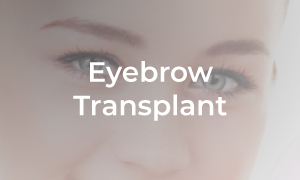Eyebrow Transplant
An eyebrow hair transplant is a procedure to transplant new hair into the eyebrow. The donor hair is coming from the scalp at the back of the head. The basic form of each of the transplanted hair is called a follicular unit (FU). There are two different techniques to obtain FU: FUT (follicular unit transplantation) or FUE (follicular unit extraction). In FUT, the operator removes a narrow skin strip from the scalp at the back of the head. The skin strip is then cut under magnification to obtain individual FUs. The wound in the scalp is closed, leaving a fine linear scar. In the FUE technique, each FU is harvested one by one by using a manual punch or motorized punch. Each FU leaves behind a tiny hole in the scalp. These tiny holes heal rapidly without the need for sutures, and there will be no visible scars.
The FUs undergo trimming to remove unnecessary tissues. The FUs are implanted into the target area using a special implanter based on the preplanned design and marking. New hair will grow from the implanted FUs to produce new hair in the brow.
Indications for eyebrow hair transplantation include the following:
-
Absence or thinning of eyebrow
-
Camouflage of eyebrow scar secondary to trauma, previous surgery, infection, or burns.
-
Thicken and lengthen the existing eyebrow.
-
To correct uneven or incomplete eyebrow.
-
To correct asymmetric eyebrows.
-
Camouflage of unsightly eyebrow tattoo.
 |
| Hair follicular unit (FU) |
Preparation
-
Inform the doctor of any pre-existing medical conditions and drug allergy. All medical conditions must be treated and stabilized before surgery.
-
Stop smoking at least one week before surgery. Smoking is harmful to wound healing, increases the risks of other post-operation complications, and adversely affects the survival of hair grafts.
-
Stop the following medications and supplements from one week before surgery until one week after surgery.
-
All supplements containing vitamin E, ginseng, ginkgo, garlic, fish oil, and other ingredients that increase bleeding during the procedure. Other supplements, traditional medicine, and herbs, in which ingredients are unknown, have to stop as well.
-
Medicine that increases bleeding during the procedure such as aspirin, NSAIDs, and warfarin. However, you may need to consult your physician who prescribed the medication before you stop them.
-
On the day of surgery, wear simple and comfortable clothing. Do not wear any makeup. Do not wear any jewelry and metal objects on the face and body.
Procedure
Duration: 2-4 hours
Anaesthesia: Local anaesthesia
Hospitalization: Not required.
Recovery*: Back to work in 3-7 days, light exercise after 1-2 weeks, heavy exercise after 4-6 weeks. * The actual recovery speed depends on the extent of the hair transplant and may vary from person to person.
Procedure: there are three steps involved in the whole process.
-
FU harvesting: There are two different techniques to harvest FU: FUT (follicular unit transplantation) or FUE (follicular unit extraction). The technique we use is FUE.
-
FU preparation: Trimming of FUs into single-hair FU or 2-hair FU.
-
FU placement: Implantation of the prepared FUs into the target area to create the desired results.
Post-operative Care**
-
What to expect: Swelling usually peaks on the second to third day after surgery and will gradually subside after that. Post-operative pain is minimal.
-
The original hair shaft from the transplanted hair will shed off, and new hair will grow from the FU. The final results may take a few months to achieve.
-
General care:
-
Avoid touch on the brow area for at least one week.
-
Avoid smoking for at least one month. Smoking increases the risk of wound complications and adversely affects the survival of the hair graft.
-
Adequate rest and sleep are helpful for a speedy recovery.
-
Be relaxed and calm. Contact the clinic if there are any queries.
-
-
Medicine: Finish the oral antibiotics as prescribed. Take the painkiller as prescribed when necessary.
-
Wound care: For the first three days, gently spray the wound with saline solution. After three days, gently clean the wound with a clean cotton tip soaked with sterile water/saline. Apply antibiotic ointment. No wound dressings are required.
-
Physical activity: Avoid heavy physical activity and exercise for at least one month.
-
Follow-up: Come back one week after surgery for review.
-
Emergency: If there is heavy bleeding, a rapid increase in swelling or severe pain, immediately contact the clinic/doctor for advice.
-
Since they come from the scalp, the transplanted hairs will grow longer than the original brow hair. Thus, the hairs need to be trimmed regularly, usually once in 2 weeks.
** The instructions in this list are only for general guidance. If you have any specific queries or concerns during the post-operative recovery, please contact the clinic for further advice.







